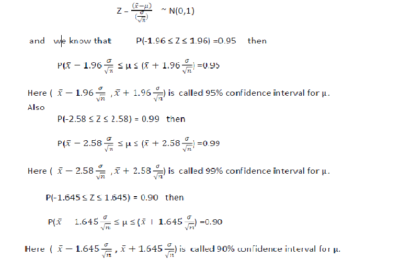Confidence intervals consist of a range of values (interval) that act as good estimates of the unknown Population parameter. However, the interval computed from a particular sample does not necessarily include the true value of the parameter. Confidence intervals were introduced to statistics by Jerzy Neyman in a paper published in 1937.
According to the Neyman, the confidence interval is given below-
We choose some small value of α (5% or 1%) and then determine two constant say c1 and c2 such that :
P( c1 < Ѳ < c2 l t ) = 1- α
The quantities c1 and c2, so determine, are known as the confidence limit or fiducial limit and the interval [c1, c2] within which the unknown value of the population parameter is expected to lie, is called the confidence interval and (1-α) is called a confidence coefficient.
Thus if we take α=0.05(or 0.01), we shall get 95%(or 99%) confidence limits.
If we take a large sample from the normal population with mean μ and standard deviation σ then
